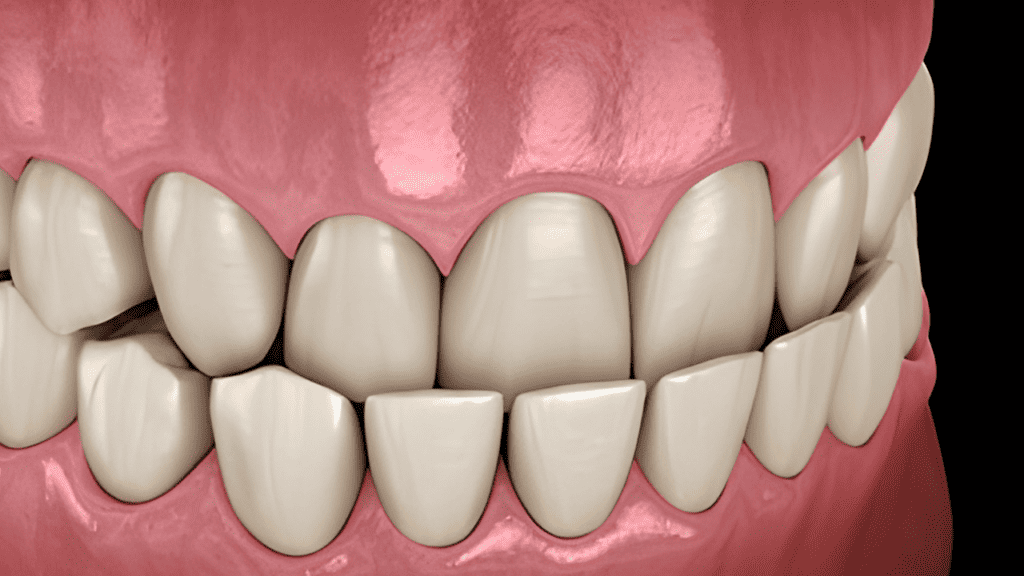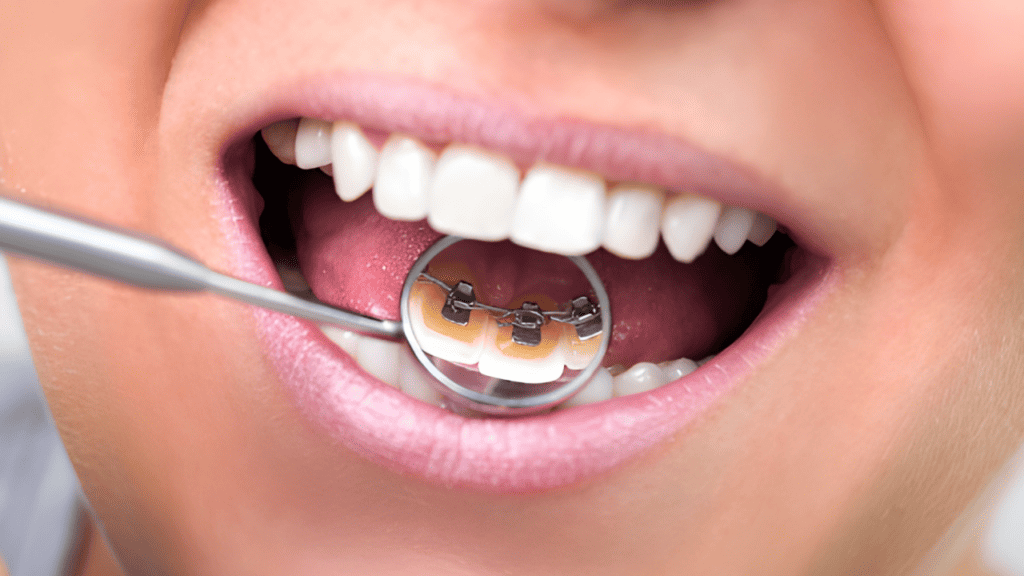If you’ve ever considered orthodontic treatment or had braces, you might have come across the term “power chains.” These tiny but mighty components play a crucial role in the process of aligning teeth and achieving a dazzling smile. In this article, we’ll delve into the world of power chains, exploring their purpose, benefits, and how they can be a crucial part to getting great results with braces. So, let’s dive in and unravel the power behind power chains!
What are Power Chains For?
Power chains, also known as elastic chains or simply “chains,” are an integral part of orthodontic treatment. They are made up of a series of interconnected elastic rings or modules. These modules are looped around individual brackets on your teeth and create continuous force, promoting tooth movement and alignment.
Power chains serve a specific purpose in orthodontic treatment: they are primarily used to close gaps between teeth. When teeth are crowded or irregularly spaced, power chains apply gentle yet consistent pressure to gradually shift the teeth closer together until the desired alignment is achieved.
What Do Power Chains Do?
The primary function of power chains is to close gaps between teeth. By exerting continuous force on the teeth, power chains facilitate the movement and alignment process. They are often used in the later stages of orthodontic treatment, once the initial alignment of teeth using braces or aligners has taken place.
Power chains come into play when gaps or spaces remain between teeth. They serve as a dynamic tool to close these gaps and ensure that each tooth finds its rightful place in the dental arch. Power chains create a controlled and predictable force that guides teeth into proper alignment, resulting in an aesthetically pleasing and functional smile.
Why Would You Need Power Chains?
After the initial alignment using braces or aligners, there may still be small spaces left between some teeth. Power chains are used to address these spaces and provide the finishing touches for a well-aligned smile.
Closing these gaps not only enhances the appearance of your smile but also improves oral health and function. When teeth are correctly aligned, it becomes easier to clean them, reducing the risk of plaque buildup and potential dental issues in the future. Not to mention it looks much better!
Types of Power Chains
Power chains come in various types and sizes, allowing orthodontists to customize treatment according to individual needs. They are available in different colors, offering patients a chance to express their personalities or embrace a festive spirit during the holiday season.
If you want to keep your braces a little more under the radar, some power chains are also translucent, blending in discreetly with the natural color of your teeth.
The color options for power chains can vary from traditional silver or clear to vibrant hues like blue, pink, or even glow-in-the-dark. This variety allows patients to add a touch of personalization and fun to their orthodontic journey.
In addition to color, power chains can vary in thickness and strength. The thickness of a power chain refers to the diameter of the elastic rings or modules. Thicker power chains provide stronger forces, while thinner ones exert milder forces. Orthodontists carefully select the appropriate power chain based on the specific needs of each patient, ensuring the best results.
How Long Do You Have Power Chains?
The duration for which power chains are worn varies from person to person. In most cases, power chains are worn for a few weeks or months. The length of time for wearing power chains depends on several factors, including the complexity of the tooth movement required and the amount of spacing that needs to be closed. Your orthodontist will provide specific instructions regarding the duration of power chain wear during your treatment.
It’s important to remember that orthodontic treatment is a gradual process, and the movement of teeth takes time. Therefore, the length of time you wear power chains may vary from other individuals undergoing similar treatment. It’s essential to follow your orthodontist’s guidance and attend regular check-ups to monitor progress and make any necessary adjustments.
Are Power Chains Painful?
One common concern among orthodontic patients is whether power chains cause discomfort or pain. It’s important to note that while power chains exert continuous force on the teeth, the pressure they apply is relatively gentle. The initial placement of power chains may cause some mild discomfort or soreness, but this usually subsides quickly as the teeth adjust to the new forces.
Every individual’s pain tolerance and sensitivity may vary, so it’s normal to experience some sensitivity or discomfort during orthodontic treatment.
Over-the-counter pain relievers and orthodontic wax can help alleviate any discomfort caused by power chains. If you experience significant pain or discomfort that persists beyond the initial adjustment period, it’s advisable to consult your orthodontist. They can assess the situation and make any necessary adjustments to ensure your comfort throughout the treatment process.
Are Power Chains Better Than Braces?
It’s important to understand that power chains and braces are not mutually exclusive but rather work in conjunction to achieve optimal results. Braces, which consist of brackets bonded to the teeth and wires that exert pressure, serve as the foundation for orthodontic treatment. Power chains, on the other hand, act as a targeted and precise tool to address specific gaps and spaces between teeth.
Braces are responsible for the initial alignment and movement of teeth. They apply force to guide the teeth into the proper position and address issues such as crowding, misalignment, and bite problems. Power chains, on the other hand, focus on closing gaps and fine-tuning the alignment. They provide the additional force needed to close remaining spaces and ensure a seamless, harmonious alignment.
Both braces and power chains have their unique roles and contributions in orthodontic treatment. They work hand in hand to achieve the desired results and create a beautiful, functional smile.
Are Power Chains the Last Step in Braces?
Power chains are often used in the final stages of braces treatment, but they may not necessarily be the last step. After the gaps have been closed and the teeth have achieved the desired alignment, there are still a few steps remaining to complete the braces journey. These steps typically involve refining the occlusion (bite) and ensuring the long-term stability of the newly aligned teeth.
Your orthodontist may recommend additional measures, such as wearing retainers, to maintain the achieved alignment and prevent any relapse. Retainers are custom-made appliances that help stabilize the teeth in their new positions and ensure the longevity of the orthodontic treatment. They are usually worn after the braces are removed and are an essential component of the post-treatment phase.
Retainers can be removable or fixed (bonded) behind the teeth. Your orthodontist will guide you on the duration and frequency of retainer wear, as it varies from person to person. Adhering to the retainer-wearing instructions is crucial to maintain the alignment achieved through braces and power chains.
Power Chains Maintenance
Proper maintenance of power chains is crucial for the success of your orthodontic treatment. By following some essential guidelines, you can ensure that your power chains effectively close gaps and contribute to achieving a beautifully aligned smile.
Oral Hygiene: Maintaining excellent oral hygiene is essential throughout your orthodontic treatment, including when wearing power chains. Brush your teeth thoroughly at least twice a day, making sure to clean around the brackets and power chains. Use a soft-bristle toothbrush and fluoride toothpaste. Flossing is also crucial, but it may require some additional effort when navigating between the power chains. Consider using floss threaders or interdental brushes to clean between the teeth effectively.
- Diet: Be mindful of your diet and avoid consuming hard, sticky, or chewy foods that can damage the power chains or get stuck between your teeth. These types of foods can potentially prolong the treatment process or even cause damage to the braces themselves. Opt for softer foods that are gentle on your braces and power chains. Cut food into smaller, manageable pieces to minimize the risk of damage.
- Regular Check-ups: Attend all scheduled appointments with your orthodontist to monitor the progress of your treatment and make any necessary adjustments. During these visits, your orthodontist will evaluate the condition of your power chains and braces. They may replace or adjust them as needed to ensure effective tooth movement and alignment. Regular check-ups also provide an opportunity for your orthodontist to address any concerns or answer any questions you may have.
- Emergency Situations: In the event of a loose or broken power chain, contact your orthodontist promptly. They will guide you on how to handle the situation and may schedule an emergency appointment if necessary. It’s important not to attempt to fix or adjust the power chain on your own, as this can cause further damage or delay the progress of your treatment.
- Compliance with Instructions: Follow all instructions provided by your orthodontist regarding power chain wear, oral hygiene, diet, and any additional recommendations specific to your treatment plan. Compliance with these instructions will ensure that your power chains work effectively and contribute to achieving the desired alignment of your teeth.
Conclusion
Power chains are a powerful tool in the realm of orthodontic treatment. They play a vital role in closing gaps between teeth, ensuring a seamless and well-aligned smile. By exerting continuous and gentle forces, power chains help guide teeth into their proper positions, addressing spacing issues and enhancing both the aesthetics and functionality of the smile.
While power chains are often used in the final stages of braces treatment, they are not necessarily the last step.
The journey towards a beautiful smile may involve additional steps, such as wearing retainers to maintain the achieved alignment and stability of the teeth.
Proper maintenance of power chains is crucial for successful orthodontic treatment. By adhering to oral hygiene practices, being mindful of your diet, attending regular check-ups, and following your orthodontist’s instructions, you can ensure that power chains effectively contribute to achieving your desired smile.
Embrace the power of power chains as you embark on your orthodontic journey, and get ready to unveil a confident, radiant smile to the world!
Colgate
Healthy Mouth
Sage Pub
Healthline
Related Articles
Lingual Braces: Pros + Cons and How They Work
Headgear Braces: Everything You Need To Know
Erica Anand is a certified dental expert. She holds a BA in Chemistry and a Doctorate of Dental Surgery from Stony Brook University. After completing a two-year pediatric dentistry program, she now runs a private practice focusing on preventive dentistry and is a member of the American Association of Dental Consultants.
Marcus Ramsey has been a professional writer for over seven years. He has talked about and produced content for industries like Dentistry, Healthcare, and more.






